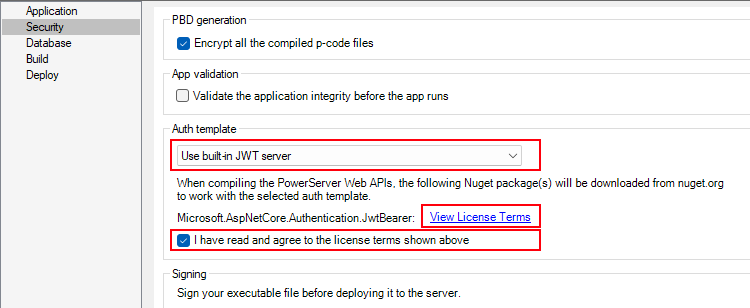Before making changes to the PowerBuilder client app, let's follow the steps below to make sure 1) the PowerBuilder application can run successfully, 2) the app has been deployed as an installable cloud app successfully, and 3) the PowerServer C# solution (including the built-in JWT server) has been successfully generated.
In this tutorial, we will take Sales Demo as an example.
Step 1: Select Windows Start | Appeon PowerBuilder 2022 R2, and then right-click Example Sales App and select More | Run as administrator.
Step 2: When the SalesDemo workspace is loaded in the PowerBuilder IDE, click the Run button in the PowerBuilder toolbar.
Step 3: When the application main window is opened, click the Address icon in the application ribbon bar and make sure data can be successfully retrieved.
Step 4: Create and configure a PowerServer project for the Sales Demo app (detailed instructions are provided in Quick Start > Guide 1).
IMPORTANT: In the Security page, select Use built-in JWT server from the Auth Template list box, view the license terms, and select the "I have read and agree to the license..." option.
Step 5: Deploy the application as an installable cloud app. The PowerServer C# solution is generated, but the installable cloud app cannot run yet because further settings and changes are required, as explained in the subsequent sections.
The PowerServer C# solution > UserExtensions project contains a built-in JWT server and the authentication class files as shown below.
-
The built-in JWT server authenticates the user credential and returns a token. The built-in server is included in the ServerAPIs project; it runs automatically when the PowerServer Web APIs (the ServerAPIs project) runs.
-
DefaultUserStore.cs defines two users by default. You can change this file to define more users. These users will be used by the built-in server to validate the users passed from the client.
The users can also be defined and stored in the database. Refer to Validate username and password against a database for more information.
-
DatabaseUserStore.cs can be added with scripts to connect with an authentication database where the users are defined and stored.
-
-
The authentication class and configuration files will be used by the PowerServer Web APIs to validate the token passed from the client and, if validation is successful, data will be obtained from the database.
-
Authentication.json contains the settings for enabling the authentication feature ("PowerServer:EnableAuthentication") and specifying the JWT token information ("JwtSetting").
The "PowerServer:EnableAuthentication" setting is set to true by default. Setting it to false will turn off the authentication feature. The "JwtSetting" block is used to specify the token information including the issuer, audience and security key.
-





